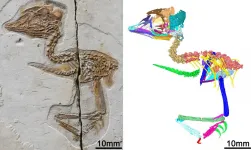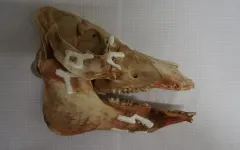Spirituality can promote the health of breast cancer survivors
MU study finds link between forgiveness, congregational support and neuroimmune biomarkers
2021-06-23
(Press-News.org) COLUMBIA, Mo. - Throughout her 20-year career as a nurse practitioner, Jennifer Hulett noticed survivors of breast cancer would often express gratitude for being alive and mention God or a divine acknowledgement that had improved their health and well-being.
Now an assistant professor at the University of Missouri Sinclair School of Nursing, Hulett is researching the benefits of spirituality on improving immune health and reducing stress, as well as the chances of cancer reoccurrence, among breast cancer survivors.
In a recent study, Hulett collected and froze samples of saliva from 41 breast cancer survivors at MU's Ellis Fischel Cancer Center. She identified breast cancer survivors' reports of practicing forgiveness and receiving positive social support from their congregation or other social support network were linked with two specific biomarkers, alpha-amylase and interleukin-6. The findings lay the foundation for further examining the role spirituality plays in the health and well-being of both cancer survivors and individuals managing chronic disease.
"Breast cancer survivors are often a highly spiritual group given the trauma they have been through, and we found they often have more positive spiritual beliefs in a loving God or higher power rather than a punitive, punishing God," Hulett said. "This confirmed what I had previously experienced anecdotally as a nurse. Breast cancer survivors would often express gratitude and contribute their health and well-being to a higher power, and they tended to have better health outcomes as well."
Hulett's research builds off previous findings indicating positive spiritual beliefs are associated with healthier levels of cortisol, a biomarker commonly associated with stress, among breast cancer survivors.
"Cortisol and stress suggest chronic inflammation, and anything we can do to lower levels of stress and inflammation will have a good effect on a patient's longevity, health outcomes and reduced risk of reoccurring disease," Hulett said. "We often hear about diet and exercise in promoting physical health, but we rarely hear about the importance of managing stress, and all three are connected with well-being."
One in eight women develop breast cancer at some point in their lives, and previous studies show chronic stress in breast cancer survivors is linked with increased inflammation and risk for cancer reoccurrence.
"We know cortisol is linked with stress, and elevated levels of the immune biomarker interleukin 6 suggests inflammation," Hulett said. "By first finding out which biomarkers are meaningful to look at, we can then see how they are potentially influenced by various spiritual or mindfulness practices aimed at reducing inflammation."
Hulett's research sets the foundation for future research that evaluates the effectiveness of spiritual and mindfulness interventions, including daily prayer, mediation, yoga and relaxation, on health outcomes among cancer survivors and individuals with chronic disease.
"We already know these interventions improve mental health, but they might also improve physical health as well, and we can try to prove it by looking at these physiological biomarkers," Hulett said. "These spiritual interventions are what nurses can use at the bedside to quickly implement if they see patients struggling to cope with their illness. Any evidence-based solutions we can equip nurses with will help improve patient health outcomes, and that is where these mind-body interventions can play a role going forward."
INFORMATION:
"Associations between religious and spiritual variables and neuroimmune activity in survivors of breast cancer: a feasibility study" was recently published in Supportive Care in Cancer. Funding for the study was provided by the National Institute of Nursing Research and the Ellis Fischel Cancer Center Donor Fund.
[Attachments] See images for this press release:

ELSE PRESS RELEASES FROM THIS DATE:
2021-06-23
Researchers from the Institute of Vertebrate Paleontology and Paleoanthropology (IVPP) of the Chinese Academy of Sciences have discovered a 120-million-year-old partial fossil skeleton of a tiny extinct bird that fits in the palm of the hand and preserves a unique skull with a mix of dinosaurian and bird features.
The two-centimeter-long (0.75 inch) skull of the fossil shares many structural and functional features with the gigantic Tyrannosaurus rex, indicating that early birds kept many features of their dinosaurian ancestors and their skulls functioned much like those of dinosaurs rather than living ...
2021-06-23
MINNEAPOLIS/ST. PAUL (06/23/2021) -- A new report from the University of Minnesota Medical School's Healthy Youth Development - Prevention Research Center (HYD-PRC) highlights that Minnesota youth continue to contract sexually transmitted infections (STIs) at alarmingly high rates, despite the COVID-19 pandemic.
The 2021 Minnesota Adolescent Sexual Health Report says that chlamydia and gonorrhea rates among Minnesota adolescents in 2020 are likely underreported, as both STI testing and case detection were scaled back during the early stages of the pandemic. However, teen pregnancy rates remain virtually unchanged from 2018, and birth rates are at historic lows for ...
2021-06-23
The stink of ammonia in urine, sweat, and rotting meat repels humans, but many insects find ammonia alluring. Now, UConn researchers have figured out how the annoying insects smell it, a discovery that could lead to better ways to make them buzz off.
The sense of smell is enormously important. Mammals devote a third of their genetic code to odor receptors found in the nose, and have more than 1,000 different kinds that allow us to smell an estimated trillion different odors.
Flies don't have noses. Instead, they smell with their antenna. Each antenna is covered with tiny hairs called sensilla. Each sensilla contains a few neurons--fly brain cells. Each neuron expresses one type of odor receptor, and they all fall into two main ...
2021-06-23
A new biocompatible polymer-based composite material could soon replace metal plates in treating difficult and unstable fractures. Developed at KTH Royal Institute of Technology in Stockholm, the newly-developed material is as strong as dental composites yet non-toxic.
The material and a surgical method, which were published in Advanced Functional Materials, will be used in clinical studies in 2023 and 2024, with a focus on hand fractures.
Michael Malkoch, professor of fibre and polymer technology at KTH, says that the material and method, AdhFix, will enable customized plating for fixation of fractures with a more comfortable, less complicated recovery. Collarbone and rib fractures in particular are ideally suited for the proposed treatment, ...
2021-06-23
During the COVID-19 pandemic, cloth face masks became a way to help protect yourself and others from the virus. And for some people, they became a fashion statement, with many fabric choices available. But just how effective are they, especially in containing a sneeze? Now, researchers reporting in ACS Biomaterials Science & Engineering used high-speed videos of a person sneezing to identify the optimal cloth mask design. Watch a video of the sneeze cam here.
Early in the pandemic, worldwide shortages of surgical masks and N95 respirators led many people to make or purchase cloth face masks. Now, with safe and effective COVID-19 vaccines available, mask restrictions are ...
2021-06-23
A new study published in the Journal of the Association for Consumer Research posits that increased accessibility to anthropomorphized luck (i.e., "lady luck") can lead consumers to be more likely to pursue higher-risk financial behavior. In "Lady Luck: Anthropomorphized Luck Creates Perceptions of Risk-Sharing and Drives Pursuit of Risky Alternatives," authors Katina Kulow, Thomas Kramer, and Kara Bentley propose that preferences for higher-risk options (like lottery tickets with worse odds or investment opportunities with a low chance of return) are driven by shared risk perceptions that might engender feelings of security provided by the idea of "lady luck." This behavior, the authors note, "bodes ill for consumer welfare, given that many financial maladaptive activities ...
2021-06-23
Beyond how much cream and sugar to add to their morning brew, coffee lovers also face more serious decisions: one of those is whether or not to buy ecolabelled coffee, which advertises itself as more ethical and environmentally friendly. But whether customers are willing to pay the extra price for these perks remains an unanswered question. In a study publishing in the journal Heliyon on June 23, researchers combined data from 22 studies to conclude that in general, people are willing to pay $1.36 more for a pound of coffee that's produced in an eco-friendly way and are especially partial to coffee that's labelled "Organic."
"We hear in the media or sometimes read in the newspaper that there ...
2021-06-23
Researchers have developed a simple lab-based technique that allows them to look inside lithium-ion batteries and follow lithium ions moving in real time as the batteries charge and discharge, something which has not been possible until now.
Using the low-cost technique, the researchers identified the speed-limiting processes which, if addressed, could enable the batteries in most smartphones and laptops to charge in as little as five minutes.
The researchers, from the University of Cambridge, say their technique will not only help improve existing battery materials, ...
2021-06-23
Denisova Cave is located in the Altai Mountains in southern Siberia and is famous for the discovery of Denisovans, an extinct form of archaic humans that is thought to have occupied large parts of central and eastern Asia. Neandertal remains have also been found at the site, as well as a bone from a child who had a Neandertal mother and Denisovan father, showing that both groups met in the region. However, only eight bone fragments and teeth of Neandertals and Denisovans have been recovered so far from the deposits in Denisova Cave, which cover ...
2021-06-23
Humans perceive the world around them with five senses - vision, hearing, taste, smell and touch. Many other animals are also able to sense the Earth's magnetic field. For some time, a collaboration of biologists, chemists and physicists centred at the Universities of Oldenburg (Germany) and Oxford (UK) have been gathering evidence suggesting that the magnetic sense of migratory birds such as European robins is based on a specific light-sensitive protein in the eye. In the current edition of the journal Nature, this team demonstrate that the protein cryptochrome 4, found in birds' retinas, is sensitive to magnetic fields and could well be the long-sought magnetic sensor.
First ...
LAST 30 PRESS RELEASES:
[Press-News.org] Spirituality can promote the health of breast cancer survivors
MU study finds link between forgiveness, congregational support and neuroimmune biomarkers





